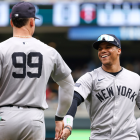The MLB is unique to other sports leagues in the sense that at some point, barring very rare circumstances, teams have to decide if they're going to be buyers or sellers at the trade deadline. The Mets passed that point a long time ago. They're 13 1/2 games back in the NL East, 13 games back in the NL wild-card race and hammered with injuries. Noah Syndergaard, for example, hit the DL just before the deadline with hand, foot and mouth disease.
The Mets stood pat at the trade deadline on Tuesday, despite having a myriad of movable players and a desperate need to do anything to keep Mets fans excited about the team's future.
Pitcher Zack Wheeler is the perfect example. Wheeler is 5-6 this season with an ERA of 4.11 in 20 starts. While the numbers aren't mind-boggling, his stuff itself has been serviceable and he's trending upward career-wise. His WHIP is a career-low 1.28 and his walks per nine is a career-low 3.1. There's potential there, but the Mets were never going to get a huge package for a pitcher that's 26-29 in his career with an ERA slightly under four.
Not only is Wheeler looking better overall, but he's also in the middle of a hot streak. Wheeler has won his last three starts, posting an ERA of 2.61 and a strikeout/walk ratio of 17-4. Basically, all of the stars aligned to move Wheeler for a pretty decent return. The Cubs trading for Cole Hamels took away the team that may have been their best suitor, but a team like the Brewers must have been on the line.
However, as the deadline approached, it was reported by Jon Heyman that the Mets weren't "hearing what they want to hear." Manager Mickey Callaway said after the deadline that "Zack Wheeler in our rotation makes us the best team we can possibly be this year, and moving forward," per Anthony DiComo. While there's something to be said for the latter half of that statement -- of course the Mets want to be better moving forward -- they shouldn't be thinking about this year. Their roster doesn't allow for that at the moment.
The team wasn't able to move Jose Bautista or Devin Mesoraco either. Both players are free agents after this year, and while it makes sense why the Mets traded for Mesoraco -- that move got Matt Harvey off the books -- why would they wait as long as they did to flip him for a return? Heyman reported that the market for Mesoraco was nonexistent on Tuesday, but that didn't appear to be the case on Monday when he reported that the Mets didn't get "the right offer yet." Bautista, meanwhile, was signed by the team in May amid a slew of injuries.
They could have apparently flipped both of these players, as Mike Puma of the New York Post reported over a week ago they were generating interest. But again, the Mets chose to sit and wait for the perfect offer that never came.
Then, of course, there's the Mets' most valuable piece, and the one player that could have been traded that you can rationalize keeping: Jacob deGrom. DeGrom is extremely valuable, not just for his production -- he has a 1.82 ERA and a 209 ERA+, not to mention a WHIP under 1 -- but also because he has two more seasons of arbitration. The 30-year-old right-hander is saying all of the right things, he seems perfectly content to remain a Met, but his agent isn't singing the same tune. He said during the All-Star break that the Mets should consider trading deGrom if they couldn't offer an extension. Now that they're apparently keeping him, at some point they need to build a team around him.
Finally, Syndergaard was reportedly getting looks from the Padres, which would have been huge. The Padres have a very deep farm system, and players that could benefit the Mets moving forward. Ultimately, nothing came of that either. Syndergaard is similar to deGrom in that he would require quite a haul, and his team control doesn't expire until 2022. He also makes sense to keep, but the Mets need to move fast if they're going to make that window count.
So the question now becomes: What's next for the Mets? Who will fill in those spots around deGrom and Syndergaard? Travis d'Arnaud is entering his third year of arbitration, before he'll become a free agent in 2020. The same can be said for Wilmer Flores, who was also a candidate to be moved. The Mets seem to be committing to Amed Rosario, who's played 99 games this season and has another two years of team control before arbitration, but he hasn't been overly impressive at shortstop. Then you hit the big contracts like David Wright, Yoenis Cespedes and Jay Bruce. Wright hit the 60-day DL in April after multiple surgeries and likely won't be back this season, Cespedes is out for the year, and Bruce is likely to return sometime in early August after a hip strain.
Cespedes and Wright, of course, were both immovable this deadline. Cespedes is making $29 million this season and next season and $29.5 million in 2020. Wright will also be a free agent in 2021, and he's making $15 million next season and $12 million the year after. And then there's Bruce, who will make $14 million in 2019 and 2020. If the Mets' plan is to be competitive in 2019 with this roster, on paper staying pat might have been the move. In practice, it only digs this team into a deeper hole, because the Braves and Phillies are on an upward curve that is much steeper than the Mets.
The team has no bats to support a solid pitching staff. Syndergaard's 6-1 record and deGrom's 5-6 record are proof of as much.
So, the moves the team made leading up to the deadline were to trade Jeurys Familia to the Athletics for two prospects and to deal Asdrubal Cabrera to the Phillies for a double-A pitcher. In a vacuum, these were decent moves. The Mets wouldn't have gotten much more for Cabrera, who's batting .277 this season and will be a free agent after the year is over. The big picture is more telling. The team is trying to rebuild without committing to a rebuild, and it's dumping salary along the way. Teams have tried doing this before, it never goes well. And it always ends in needing to commit to a full rebuild.
The Mets needed to do more, and they failed to do so.
So, how did the Mets' trade deadline end? A whopping 25-4 loss to the Washington Nationals that saw Jose Reyes on the mound for the first time in his career. Steven Matz, another player the Mets kept (though that decision was relatively reasonable), got two outs and gave up seven runs. It was the worst loss in franchise history. The box score was something out of a video game.
The most lopsided loss in the history of the New York Mets. pic.twitter.com/RivdmhKSz7
— Don Van Natta Jr. (@DVNJr) August 1, 2018
Miraculously, it still felt like the team's second-worst loss of the day. A 25-4 loss is just one in the loss column. But missing out on golden opportunities to move players and giving your fans something -- anything -- to be excited about? That's going to sting a lot longer.






















